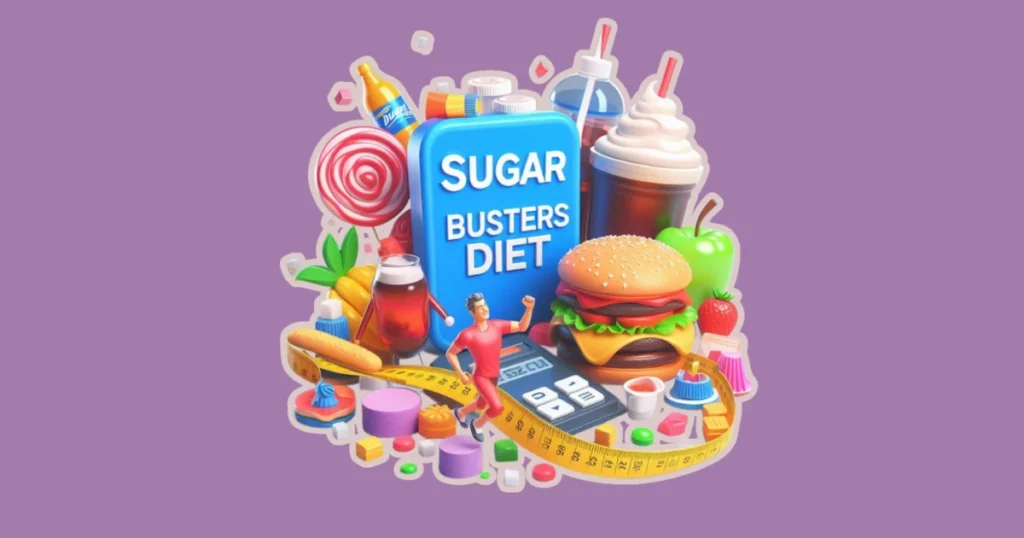
In recent decades, the Sugar Busters Diet has garnered considerable attention and popularity. A collective of medical professionals released a book in 1995 that introduced this dietary approach, emphasizing the reduction of refined carbohydrates and added sugars while promoting the consumption of lean proteins, healthy fats, and fiber-rich fruits and vegetables. While some critics regard it as merely a trend, proponents assert that the diet can facilitate weight loss, regulate blood sugar levels, and enhance cardiovascular health. This article examines the Sugar Busters Diet and its efficacy in promoting weight loss.
How does the Sugar Busters Diet work?
The premise of the Sugar Busters Diet states that sugar is detrimental to health and can lead to weight gain by elevating insulin levels.
Insulin is the hormone responsible for moving sugar from the bloodstream into cells and plays a crucial role in managing energy storage within the body. Numerous studies have linked persistently elevated insulin levels to weight gain.
To reduce insulin levels, this dietary approach emphasizes the elimination of foods with a high glycemic index (GI), which indicates how rapidly a particular food can raise blood sugar levels.
Instead of high-carbohydrate foods such as pasta, white flour, and sugary treats, the diet promotes the consumption of low-glycemic and fiber-rich options, including legumes, whole grains, healthy fats, and proteins.
Diet guidelines
The authors advocate for a carbohydrate intake that constitutes roughly 40% of daily caloric intake, with fats and proteins each accounting for 30%.
Although the authors label this dietary regimen as a “correct carbohydrate lifestyle,” some references may classify these macronutrient distributions as a mild low-carb diet.
Additionally, the book encourages the reduction of saturated fats by selecting low-fat dairy products and lean meat cuts. Unlike many popular diets, the Sugar Busters Diet does not require the acquisition of high-priced ingredients, specialized tools, or expensive membership plans. The plan also intends for long-term adherence.
Additionally, you don’t have to track calories, and the plan doesn’t impose strict rules on how much physical activity you should include in your daily routine.
This dietary regimen suggests minimizing the consumption of refined carbohydrates and processed foods that are high in calories but low in essential nutrients.
The authors contend that incorporating healthy, fiber-rich foods can contribute to stabilizing blood sugar, reducing cholesterol levels, and managing blood pressure effectively.
Can it support you in losing weight?
The Sugar Busters Diet does not require individuals to monitor calorie intake or track nutritional values; instead, it emphasizes the importance of minimizing the consumption of refined carbohydrates and added sugars.
While the research surrounding this diet is somewhat sparse, there is evidence to suggest that it may be an effective method for achieving weight loss.
For instance, a study involving 2,834 adults revealed a correlation between a higher intake of refined carbohydrates and an increase in abdominal fat, whereas a greater consumption of whole grains was associated with a reduction in belly fat.
Furthermore, a large-scale review of 32 studies demonstrated that the intake of sugar-sweetened beverages is associated with weight gain in both adults and children.
In contrast, increasing fiber intake can help regulate blood sugar levels, slow gastric emptying, enhance feelings of fullness, lower calorie consumption, and support weight loss efforts.
Several studies have demonstrated that low-carbohydrate, high-protein diets, such as the Sugar Busters Diet, are effective in alleviating hunger, facilitating weight loss, and decreasing body fat.
A particular 10-week study involving 89 overweight and obese women assessed the impact of a high-protein, high-fiber diet against a high-carbohydrate, low-fat diet.
The results showed that those following the high-fiber, high-protein diet lost significantly more weight and body fat compared to their counterparts on the high-carbohydrate, low-fat diet.
Thus, the Sugar Busters Diet may contribute to appetite suppression and reduced caloric intake, aiding in weight loss; however, further research on the diet itself is essential.
Other benefits
The Sugar Busters Diet is not only effective for weight loss but may also offer a range of additional health benefits. By minimizing the intake of high-glycemic foods and refined carbohydrates, it may aid in stabilizing blood sugar levels and improving heart health.
A comprehensive two-year study involving 307 subjects demonstrated that participants adhering to a low-carbohydrate diet showed marked improvements in several risk factors associated with heart disease.
Those on the low-carb regimen experienced more significant increases in HDL (good) cholesterol and greater reductions in diastolic blood pressure, triglycerides, and LDL (bad) cholesterol relative to those following low-fat diets.
A separate investigation revealed that a low-carbohydrate diet out performed a low-fat diet in lowering fasting blood sugar levels and hemoglobin A1C, which serves as an indicator of long-term blood sugar management, among individuals with type 2 diabetes.
Furthermore, eliminating added sugars can help mitigate inflammation within the body. Chronic inflammation has been associated with the development and advancement of various health issues, including cardiovascular disease, certain types of cancer, and obesity.
The Sugar Busters Diet offers additional advantages, such as requiring minimal nutritional expertise, being straightforward to adhere to, and lacking complex rules or regulations. This makes it an appealing option for individuals aiming to lose weight and enhance their health without the need for costly diet products or meticulous calorie and macronutrient calculations.
Downsides
The Sugar Busters Diet is characterized by its strict limitations on certain food items, including those that are rich in vital vitamins and minerals, such as particular fruits and starchy vegetables.
This diet does not prioritize a comprehensive and nutritious eating plan; instead, it tends to categorize foods as either “good” or “bad,” potentially leading to the development of detrimental eating habits.
While it is true that reducing added sugars and refined carbohydrates can positively impact health, the long-term exclusion of sugary foods may be difficult for many individuals and could result in heightened cravings.
Additionally, the diet promotes the consumption of sugar substitutes like aspartame, saccharin, and sucralose.
Although these widely used sweeteners have received approval from the Food and Drug Administration (FDA), studies indicate that they could lead to negative health consequences.
For example, artificial sweeteners can potentially disrupt blood sugar regulation, influence appetite, and affect body weight, as well as harm the beneficial bacteria present in the gut.
Furthermore, the Sugar Busters Diet fails to provide explicit recommendations on other crucial elements of a healthy lifestyle, such as portion sizes and physical activity.
As a result, while this diet may be effective for achieving short-term weight loss, it is important to complement it with other lifestyle changes and behavioral modifications to ensure long-term success.
Foods to eat
The Sugar Busters Diet emphasizes the intake of low-glycemic fruits and fiber-rich foods, including whole grains and vegetables.
Additionally, it permits lean proteins, healthy fats, and low-fat, sugar-free dairy products.
The diet suggests the following categories of foods:
- Fruits: apples, oranges, strawberries, blackberries, raspberries, peaches, watermelon, etc.
- Vegetables: asparagus, broccoli, cauliflower, sweet potatoes, tomatoes, etc.
- Whole grains: include a variety of options such as oats, brown rice, barley, buckwheat, and couscous, among others.
- Proteins: lean meats, poultry, seafood, eggs, legumes
- Dairy products: low-fat or fat-free milk, cheese, and yogurt without added sugar
- Fats: nuts, seeds, olive oil, vegetable oils, etc.
- Sugar substitutes: stevia, sucralose, saccharin, aspartame, etc.
Foods to avoid
According to the Sugar Busters Diet, individuals should refrain from consuming high-glycemic fruits, starchy vegetables, and refined grains.
In addition, it is crucial to exclude processed foods, sugar-laden beverages, and sweeteners such as sugar, honey, and syrup.
Limiting certain foods is also recommended.
- High-glycemic index fruits consist of items such as pineapples, ripe bananas, mangoes, kiwis, and an assortment of dried fruits.
- Starchy vegetables: potatoes, corn, plantains, peas, parsnips, etc.
- Refined grains: include products such as white bread, pasta, white rice, and items made from white flour.
- Processed foods: crackers, chips, prepackaged snacks, fast food, etc.
- Sweeteners: sugar, honey, syrup, agave, etc.
- Sugary foods: ice cream, candy, cookies, cakes, etc.
- Sugar-sweetened beverages: soda, sports drinks, sweet tea, fruit juice, etc.
The bottom line
The Sugar Busters Diet eliminates refined carbohydrates and added sugars, promoting the consumption of specific fruits, vegetables, whole grains, lean proteins, and healthy fats.
While its principles have demonstrated benefits for weight loss, blood sugar regulation, and cardiovascular health, the diet has not undergone extensive research.
For those considering this diet, it is advisable to combine it with additional lifestyle adjustments and behavioral changes to enhance its effectiveness for sustained weight loss and improved overall health.


